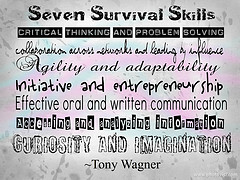|
|
|
Monday, April 28th, 2014

If you were asked what skills are in shortest supply in the workforce you would probably think first about computer and related skills.
While that is correct, some simple soft skills are just as difficult.
This year’s pair of April surveys confirmed that, as in previous years, employers are having trouble finding people with advanced computer and interpersonal skills, punctuality, and reliability.
Think about it.
Problems finding people who understand that they need to
- consistently show up at the agreed upon time; and
- always do what they say they will do.
Not exactly rocket science, but a substantial problem.
The first shows that 36% of businesses in the manufacturing sector that responded to the survey are having moderate difficulty finding workers who are punctual and reliable, while 11% report great difficulty in finding workers with those traits. In the services sector, it’s not as bad — 22% of respondents report moderate difficulty finding punctual, reliable workers, whereas only 3% report great difficulty.
The interpersonal skills are a far more significant concern.
In an age when face-to-face communications is giving way to texting, IMing and email, the ability to work in close proximity with people and not only get along, but bond to create high performing teams, is becoming more and more difficult.
Hard skills, from learning new programming languages or moving from technical work on a financial program to developing mobile apps are learnable, as are all hard skills.
Changing and redirecting the character traits that lead to being punctual and reliable or teaching interpersonal skills to a (probably) uninterested party are most often exercises in frustration.
These are the core reasons why attitude and aptitude are more important than current skills when hiring and a subject we’ll look at in more depth this week.
Image credit: Denise Krebs
Posted in Hiring, Motivation | No Comments »
Tuesday, April 8th, 2014
 Let me start by saying that I’m the CEO of a company that specifically seeks older developers – most of my team is over 40 years old. In fact, my belief is that before professionals have at least 10 years of experience under their belt, it is rare that they have developed the deep experience and judgment I need, regardless of their field of endeavor. Let me start by saying that I’m the CEO of a company that specifically seeks older developers – most of my team is over 40 years old. In fact, my belief is that before professionals have at least 10 years of experience under their belt, it is rare that they have developed the deep experience and judgment I need, regardless of their field of endeavor.
Recently, there have been a number of articles describing vicious age discrimination in Silicon Valley. I know firsthand that it’s real, but nothing is ever completely one-sided.
Along with ageism on the side of the young, there is a certain amount of self-sabotage on the other side—foremost because as people get older and more experienced they have expectations that are very different from those of younger developers.
As a pre-funded startup EMANIO follows the path of other software startups, i.e., build a working prototype and have some customers using it before seeking funding.
This is a more involved process when building an enterprise product than one that focuses on consumers, because consumers seldom have IT departments and processes that slow or prevent our gathering of information.
Doing a software startup requires a development team willing to work for stock options and/or with minimal cash payments until we have accomplished building the prototype and having some customers using it. If older programmers aren’t in a position or willing to do this, it is impossible for a pre-funded startup to hire them.
This is a clear advantage that younger developers have – their expenses are generally lower as they haven’t yet bought homes, started families, etc.
Another thing that may come from age and experience is a certain annoyance in once again having to prove oneself—or learn new tricks.
Many of the programming languages and methodologies that were popular have changed. Agile methodologies and new languages abound and older programmers must take the initiatives to become familiar with them—usually on their own time. Few young companies have the time or money to teach people these skills.
However, with the number of free, online classes available from places like MIT, Harvard and others, learning new languages and methodologies should be an easy task for those with the right attitude. Few, if any, companies care where or how programmers learn Ruby and other languages, as long as developers are proficient and productive.
On another note, in our present economy most job opportunities come from personal networks. As such, being part of a team and proving oneself is absolutely necessary in order to be asked to be part of another team.
Spending 3-6 months in a pre-funded startup is almost a prerequisite for being asked to join another team, regardless of whether the initial startup was successful or not.
Older developers have to adjust to this change in the job market—and even when their skills are highly sought after they may need to adjust their expectations.
This includes learning how to relate to very young and/or inexperienced team members and at times acting as a mentor, without seeming like a parent or overbearing or a fun-killer.
Everyone is searching for talent—cheap, productive talent is always welcome most places I know. The cheap does not have to last for a long time; usually just long enough to get your foot in the door.
(See Entrepreneurs: the Shallowness of Youth and the Myth of Age for more information and links to other articles.)
Flickr image credit: Cliff
Posted in Culture, Hiring | 10 Comments »
Thursday, December 26th, 2013
No matter the job market, founders go on and on about the lack of the right talent for their needs.
I, on the other hand, and others like me, keep saying that attitude is more important than skills.
Want proof?
OK, answer this question.
If you were a basketball coach would you want a one-handed player?
No?
Boy, is that a bad assumption-based decision.
Kind of like assuming that skills are age or school-based.
YouTube credit: ScoutsFocus.com
Posted in Entrepreneurs, Hiring | No Comments »
Friday, November 22nd, 2013
A Friday series exploring Startups and the people who make them go. Read all If the Shoe Fits posts here

Everyone is talking about Steve Ballmer’s words in a WSJ interview, “Maybe I’m an emblem of an old era, and I have to move on,” and the agreement it drew from Salesforce.com’s CEO Marc Benioff.
Benioff doesn’t care about age, born in 1964 he’s no spring chicken, but he does care about attitude.
“The world has changed. The companies that are struggling in the market today have not gone cloud. They have not gone social. They have not gone mobile. They are still trying to sell the same old stuff.”
Consider all the folks you didn’t hire because they “didn’t fit in,” which was a nice way of saying they were older than you/your friends.
Now consider that in 2009 80% of “total entrepreneurial activity” was over 35 and that hasn’t changed.
No one accuses Salesforce.com of lagging behind or slacking on innovation.
Larry Page turned 40 this year, but Google isn’t exactly sitting back on its laurels or ignoring whatever part of the changing landscape they aren’t changing themselves.
If someone said they knew a great 46 year old design guy how interested would you be?
Is 46 a turnoff?
Oops; you just missed out on Jony Ive.
Image credit: HikingArtist
Posted in Entrepreneurs, If the Shoe Fits | No Comments »
Tuesday, August 13th, 2013
 Here are the three main things to consider when hiring in order of their importance. Here are the three main things to consider when hiring in order of their importance.
They aren’t rocket science, but they work.
- Attitude—convincing someone to change it is like convincing the horse to drink the water.
- Skills—can be learned; look for the frequency of job moves that required new skills.
- Degrees—are like new cars that lose value the minute you take them off the lot.
Make sure the culture and management style they expect, based on discussions when interviewing, is what they get.
And practice daily the three main actions that will keep them loyal.
- Appreciate them.
- Provide ways for them to make a difference and notice when they do.
- Provide feedback and challenges to help them grow.
Again, not rocket science.
Flickr image credit: Simon Cocks
Posted in Ducks In A Row, Hiring | 1 Comment »
Friday, April 19th, 2013
A Friday series exploring Startups and the people who make them go. Read allIf the Shoe Fits posts here
 Jody Foster is chair of the department of psychiatry at Pennsylvania Hospital; immediately after receiving her MBA she has a very different experience assessing startup teams for VCs considering investing. Jody Foster is chair of the department of psychiatry at Pennsylvania Hospital; immediately after receiving her MBA she has a very different experience assessing startup teams for VCs considering investing.
…to understand who the main players in that company were, how the team functioned together, what kinds of personalities they had, and which ones needed watching as the company, and the venture capitalists’ investment, grew.
I’ve said for years that people aren’t faucets and can’t/don’t turn their feelings and attitudes on and off depending where they are; Foster puts it differently.
“People are people, no matter what industry they are in, and they bring their basic personalities to work,” says Foster. “When they act out in inappropriate ways — by, for example, bullying employees who work under them, compulsively micro managing, displaying narcissistic tendencies — it can be devastating to the entire workplace.”
Founders need to evaluate potential new hires as objectively as Foster would.
That means ignoring their skills and looking at the whole person warts and all.
Your team can survive a person with great attitude, but weaker skills, until they strengthen and grow.
What your team won’t survive is the so-called star with superb skills who brings with them the traits Foster mentions or any that are in direct opposition to the culture you are creating.
They will destroy you.
Image credit: HikingArtist
Posted in Entrepreneurs, Hiring, If the Shoe Fits | No Comments »
Monday, January 14th, 2013

“When they discover the center of the universe, how many people you know will be disappointed that they are not it?” —Bernard Baily
How many of them have you interviewed? How many of your recent hires required remedial coaching to understand how the real world works?
It’s a well-known fact that actions and attitudes are contagious—yawn and others will start yawning, smile and they will smile—and entitlement, the attitude of “I am special, therefore I deserve…” is catching and not necessarily age-related.
You see it when you’re driving and shopping, but it’s most annoying at work.
More and more bosses are seeing that attitude and not just in their younger workers.
The deprived generation of the Depression raised the entitled generation of Boomers who raised the much entitled, very special generation of Millennials who are raising a yet more special, more entitled generation.
And so it goes.
But there is a kind of rough justice best captured in the attitude of ‘what goes around comes around’ or, more specifically, ‘as you sow, so shall you reap’.
Guess who will be hiring all these special kids in a decade or two.
Flickr image credit: Maudy Apon
Posted in Hiring | No Comments »
Friday, August 24th, 2012
A Friday series exploring Startups and the people who make them go. Read all If the Shoe Fits posts here
 David Strickland, administrator of the National Highway Traffic Safety Administration, may not have the kind of background you typically look to as a role model. David Strickland, administrator of the National Highway Traffic Safety Administration, may not have the kind of background you typically look to as a role model.
In this short interview he talks about the attitudes and approaches that worked for him.
I think three of the most important points he makes are in bold with my added commentary.
- Learn to disagree without being disagreeable: disagreeable refers to much more than hostility, anger and raised voices; it includes, but is not limited to, eye rolls, glares, sniffs, snickers, snarky responses and martyred expressions.
- Present a problem and your proposed solution together: you need to hear about every difficulty and challenge your team faces, but it’s better to encourage your people to think them through and present possible solutions along with the problem, instead of having them come across like complaints.
- You are not bigger than the mission: even if you’re the founder. Once other people buy into your vision the mission becomes larger. You are not the sun; decisions should be based on what is best for the mission, whether or not they are best for you.
You’ve probably heard them before, but that doesn’t mean they sank in or that you are practicing them.
I find many younger entrepreneurs tend to write off people like Strickland, because of his age, experience or work; they prefer role models from their peers or with high profiles.
More fools they.
Option Sanity™ supports the mission.
Come visit Option Sanity for an easy-to-understand, simple-to-implement stock allocation system. It’s so easy a CEO can do it.
Warning.
Do not attempt to use Option Sanity™ without a strong commitment to business planning, financial controls, honesty, ethics, and “doing the right thing.”
Use only as directed.
Users of Option Sanity may experience sudden increases in team cohesion and worker satisfaction. In cases where team productivity, retention and company success is greater than typical, expect media interest and invitations as keynote speaker.
Flickr image credit: HikingArtist
Posted in If the Shoe Fits, Leadership, Personal Growth | No Comments »
Tuesday, August 7th, 2012
 Brian LaFaille is young; just 12 months out of school and into the workforce, yet the attitude he recommends for other newbies is one managers at any level would, metaphorically speaking, kill to have on their team. Brian LaFaille is young; just 12 months out of school and into the workforce, yet the attitude he recommends for other newbies is one managers at any level would, metaphorically speaking, kill to have on their team.
Additionally, many (all?) of the 10 lessons he says he learned in his first year have gone unlearned by people with 10, 20 even 30 times his experience.
Haven’t learned of just forgotten; either way they are the lessons and actions of the best employees, whether in a startup or a Fortune 25 Corporation.
Most are self explanatory, but Brian’s detailed explanation of each is worth reading.
- Take Advantage of the Seasoned Veterans Around You (or the don’t-know-any-better newbies –Miki)
- Find a Passion Outside of Work
- Be Active and Get Healthy
- Never Think You’re Too Junior (or senior –Miki)
- Constantly Challenge Yourself
- Learn About Every Part of Your Company
- Never Limit Yourself to One Role
- Grab a Good Pair of Headphones
- Don’t Be Afraid to Propose a Change
- Work hard, but Work Smart
Now answer these questions:
- Which do you do now?
- Which did you used to do?
- Which will you do in the future?
Flickr image credit: Mike McCune
Posted in Ducks In A Row, Personal Growth | No Comments »
Saturday, July 21st, 2012
 Managing, retaining and hiring employees are three of the most important actions I any company of any size and in any location. Managing, retaining and hiring employees are three of the most important actions I any company of any size and in any location.
It’s ironically amusing that it amazed some of the biggest names in workforce research to find that minimally improved management yielded enormous payback. Of course, workers have been saying that for decades when they vote with their feet.
What’s worth as much as a 25% increase in your labor force, or a 65% increase in the amount of your invested capital? A one-point improvement in your company’s management practices! That’s the shocking conclusion of in-depth study conducted by researchers at McKinsey, Stanford, and the London School of Economics that looked at more than 4,000 companies in the US, Asia, and Europe.
Fred Wilson is a top VC who also has a ton of common sense; while his focus is startups his advice is applicable to any company. Here he discusses six requisites to retaining your people.
There isn’t one secret method to retain employees but there are a few things that make a big difference. (…) Communication…, Getting the hiring process right…, Culture and Fit…, Promote from within…, Assess yourself, your team, and your company…, Pay your team well.
Attitude is what makes some people more successful than others and attitude is the result of what you believe. Inc. spotlights nine beliefs that are commonly found in successful people.
The most successful people in business approach their work differently than most. See how they think–and why it works.
Every manager looks for good ways to learn about candidates and every candidate loves insight as to what they might be asked. Inc. suggests managers ask the same questions about previous jobs.
Go through each job and ask the same three questions:
- How did you find out about the job?
- What did you like about the job before you started?
- Why did you leave?
Finally, when job hunting resumes are key, so it’s good to know why, when and how to better your chances. Here are six examples (five were hired) of using creativity to get noticed. After that, you need plenty of substance to back it up.
“One-in-five HR managers reported that they spend less than 30 seconds reviewing applications and around 40 percent spend less than one minute,” Rosemary Haefner, Vice President of Human Resources at CareerBuilder said in a study released today.
Be sure to take time to enjoy your weekend!
Flickr image credit: pedroelcarvalho
Posted in Expand Your Mind | No Comments »
|
 Subscribe to
Subscribe to
MAPping Company Success
About Miki 
Clarify your exec summary, website, etc.
Have a quick question or just want to chat? Feel free to write or call me at 360.335.8054
The 12 Ingredients of a Fillable Req
CheatSheet for InterviewERS
CheatSheet for InterviewEEs™
Give your mind a rest. Here are 4 quick ways to get rid of kinks, break a logjam or juice your creativity!
Creative mousing
Bubblewrap!
Animal innovation
Brain teaser
The latest disaster is here at home; donate to the East Coast recovery efforts now!
Text REDCROSS to 90999 to make a $10 donation or call 00.733.2767. $10 really really does make a difference and you'll never miss it.
And always donate what you can whenever you can
The following accept cash and in-kind donations: Doctors Without Borders, UNICEF, Red Cross, World Food Program, Save the Children
*/
?>About Miki
About KG
Clarify your exec summary, website, marketing collateral, etc.
Have a question or just want to chat @ no cost? Feel free to write
Download useful assistance now.
Entrepreneurs face difficulties that are hard for most people to imagine, let alone understand. You can find anonymous help and connections that do understand at 7 cups of tea.
Crises never end.
$10 really does make a difference and you’ll never miss it,
while $10 a month has exponential power.
Always donate what you can whenever you can.
The following accept cash and in-kind donations:
|







 Here are the three main things to consider when hiring in order of their importance.
Here are the three main things to consider when hiring in order of their importance.
 Brian LaFaille is young; just 12 months out of school and into the workforce, yet the
Brian LaFaille is young; just 12 months out of school and into the workforce, yet the  Managing, retaining and hiring employees are three of the most important actions I any company of any size and in any location.
Managing, retaining and hiring employees are three of the most important actions I any company of any size and in any location.
